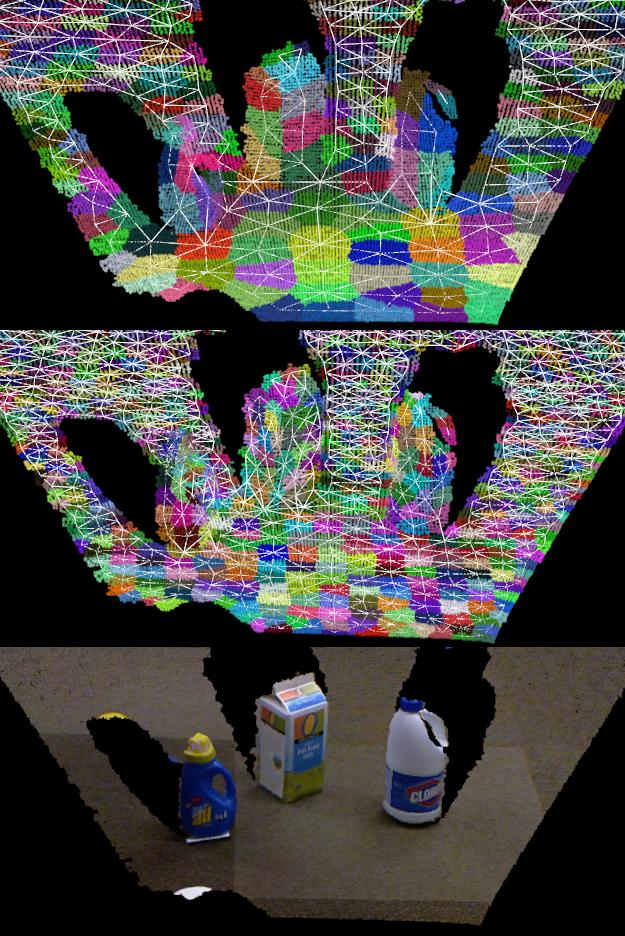介紹
“Clustering of Pointclouds into Supervoxels” 是一種點云數據聚類的方法,用于將點云數據分割成具有相似特征的超體素(supervoxel)。
超體素是一種在點云數據中表示連續區域的方法,類似于像素在圖像中表示連續區域。超體素是點云數據的小塊區域,具有相似的幾何特征和顏色特征。通過將點云數據聚類成超體素,可以實現對點云數據的語義分割和對象識別。
“Clustering of Pointclouds into Supervoxels” 方法的主要步驟如下:
-
首先,對輸入的點云數據進行預處理,包括點云濾波、法線估計等操作,以獲取點云的幾何和顏色特征。
-
然后,通過選擇一個種子點(seed point)開始,使用一種聚類算法(如歐幾里得聚類或基于圖的聚類)將點云數據分割成超體素。聚類過程中,會考慮點云的幾何和顏色特征,以確保超體素內的點具有相似的特征。
-
聚類過程中,可以根據一些準則(如緊密度、顏色一致性等)對超體素進行合并或分割,以進一步優化聚類結果。
-
最后,生成的超體素可以用于點云的語義分割、對象識別等應用。可以根據超體素的特征,將點云數據劃分為不同的對象或區域。
“Clustering of Pointclouds into Supervoxels” 方法在點云處理和分析中具有廣泛的應用,特別是在三維場景理解、目標檢測和機器人導航等領域。通過將點云數據聚類為超體素,可以提取出具有語義信息的局部區域,為后續的處理和分析提供更準確和可靠的數據基礎。
效果

代碼
#include <pcl/console/parse.h>
#include <pcl/point_cloud.h>
#include <pcl/point_types.h>
#include <pcl/io/pcd_io.h>
#include <pcl/visualization/pcl_visualizer.h>
#include <pcl/segmentation/supervoxel_clustering.h>//VTK include needed for drawing graph lines
#include <vtkPolyLine.h>// Types
typedef pcl::PointXYZRGBA PointT;
typedef pcl::PointCloud<PointT> PointCloudT;
typedef pcl::PointNormal PointNT;
typedef pcl::PointCloud<PointNT> PointNCloudT;
typedef pcl::PointXYZL PointLT;
typedef pcl::PointCloud<PointLT> PointLCloudT;void addSupervoxelConnectionsToViewer (PointT &supervoxel_center,PointCloudT &adjacent_supervoxel_centers,std::string supervoxel_name,pcl::visualization::PCLVisualizer::Ptr & viewer);int main (int argc, char ** argv)
{if (argc < 2){pcl::console::print_error ("Syntax is: %s <pcd-file> \n ""--NT Dsables the single cloud transform \n""-v <voxel resolution>\n-s <seed resolution>\n""-c <color weight> \n-z <spatial weight> \n""-n <normal_weight>\n", argv[0]);return (1);}PointCloudT::Ptr cloud (new PointCloudT);pcl::console::print_highlight ("Loading point cloud...\n");if (pcl::io::loadPCDFile<PointT> (argv[1], *cloud)){pcl::console::print_error ("Error loading cloud file!\n");return (1);}bool disable_transform = pcl::console::find_switch (argc, argv, "--NT");float voxel_resolution = 0.008f;// 用于體素化點云數據的分辨率bool voxel_res_specified = pcl::console::find_switch (argc, argv, "-v");if (voxel_res_specified)pcl::console::parse (argc, argv, "-v", voxel_resolution);float seed_resolution = 0.1f; // 用于種子點選擇的分辨率bool seed_res_specified = pcl::console::find_switch (argc, argv, "-s");if (seed_res_specified)pcl::console::parse (argc, argv, "-s", seed_resolution);float color_importance = 0.2f;if (pcl::console::find_switch (argc, argv, "-c"))pcl::console::parse (argc, argv, "-c", color_importance);float spatial_importance = 0.4f;if (pcl::console::find_switch (argc, argv, "-z"))pcl::console::parse (argc, argv, "-z", spatial_importance);float normal_importance = 1.0f;if (pcl::console::find_switch (argc, argv, "-n"))pcl::console::parse (argc, argv, "-n", normal_importance);// //// This is how to use supervoxels// //pcl::SupervoxelClustering<PointT> super (voxel_resolution, seed_resolution);if (disable_transform)super.setUseSingleCameraTransform (false);super.setInputCloud (cloud);super.setColorImportance (color_importance); // 設置顏色重要性super.setSpatialImportance (spatial_importance); // 設置空間重要性super.setNormalImportance (normal_importance); // 設置法線重要性std::map <std::uint32_t, pcl::Supervoxel<PointT>::Ptr > supervoxel_clusters;pcl::console::print_highlight ("Extracting supervoxels!\n");super.extract (supervoxel_clusters);pcl::console::print_info ("Found %d supervoxels\n", supervoxel_clusters.size ());pcl::visualization::PCLVisualizer::Ptr viewer (new pcl::visualization::PCLVisualizer ("3D Viewer"));viewer->setBackgroundColor (0, 0, 0);PointCloudT::Ptr voxel_centroid_cloud = super.getVoxelCentroidCloud (); // 獲取超體素的體素質心點云viewer->addPointCloud (voxel_centroid_cloud, "voxel centroids");viewer->setPointCloudRenderingProperties (pcl::visualization::PCL_VISUALIZER_POINT_SIZE,2.0, "voxel centroids");viewer->setPointCloudRenderingProperties (pcl::visualization::PCL_VISUALIZER_OPACITY,0.95, "voxel centroids");PointLCloudT::Ptr labeled_voxel_cloud = super.getLabeledVoxelCloud (); // 獲取標記過的點云viewer->addPointCloud (labeled_voxel_cloud, "labeled voxels");viewer->setPointCloudRenderingProperties (pcl::visualization::PCL_VISUALIZER_OPACITY,0.8, "labeled voxels");PointNCloudT::Ptr sv_normal_cloud = super.makeSupervoxelNormalCloud (supervoxel_clusters); //獲取超體素的法線點云//We have this disabled so graph is easy to see, uncomment to see supervoxel normals//viewer->addPointCloudNormals<PointNormal> (sv_normal_cloud,1,0.05f, "supervoxel_normals");pcl::console::print_highlight ("Getting supervoxel adjacency\n");std::multimap<std::uint32_t, std::uint32_t> supervoxel_adjacency;super.getSupervoxelAdjacency (supervoxel_adjacency); // 獲取超體素的鄰接關系//To make a graph of the supervoxel adjacency, we need to iterate through the supervoxel adjacency multimapor (auto label_itr = supervoxel_adjacency.cbegin (); label_itr != supervoxel_adjacency.cend (); ){//First get the labelstd::uint32_t supervoxel_label = label_itr->first;//Now get the supervoxel corresponding to the labelpcl::Supervoxel<PointT>::Ptr supervoxel = supervoxel_clusters.at (supervoxel_label);//Now we need to iterate through the adjacent supervoxels and make a point cloud of themPointCloudT adjacent_supervoxel_centers;for (auto adjacent_itr = supervoxel_adjacency.equal_range (supervoxel_label).first; adjacent_itr!=supervoxel_adjacency.equal_range (supervoxel_label).second; ++adjacent_itr){pcl::Supervoxel<PointT>::Ptr neighbor_supervoxel = supervoxel_clusters.at (adjacent_itr->second);adjacent_supervoxel_centers.push_back (neighbor_supervoxel->centroid_);}//Now we make a name for this polygonstd::stringstream ss;ss << "supervoxel_" << supervoxel_label;//This function is shown below, but is beyond the scope of this tutorial - basically it just generates a "star" polygon mesh from the points givenaddSupervoxelConnectionsToViewer (supervoxel->centroid_, adjacent_supervoxel_centers, ss.str (), viewer);//Move iterator forward to next labellabel_itr = supervoxel_adjacency.upper_bound (supervoxel_label);}while (!viewer->wasStopped ()){viewer->spinOnce (100);}return (0);}void addSupervoxelConnectionsToViewer (PointT &supervoxel_center,PointCloudT &adjacent_supervoxel_centers,std::string supervoxel_name,pcl::visualization::PCLVisualizer::Ptr & viewer){vtkSmartPointer<vtkPoints> points = vtkSmartPointer<vtkPoints>::New ();vtkSmartPointer<vtkCellArray> cells = vtkSmartPointer<vtkCellArray>::New ();vtkSmartPointer<vtkPolyLine> polyLine = vtkSmartPointer<vtkPolyLine>::New ();//Iterate through all adjacent points, and add a center point to adjacent point pairfor (auto adjacent_itr = adjacent_supervoxel_centers.begin (); adjacent_itr != adjacent_supervoxel_centers.end (); ++adjacent_itr){points->InsertNextPoint (supervoxel_center.data);points->InsertNextPoint (adjacent_itr->data);}// Create a polydata to store everything invtkSmartPointer<vtkPolyData> polyData = vtkSmartPointer<vtkPolyData>::New ();// Add the points to the datasetpolyData->SetPoints (points);polyLine->GetPointIds ()->SetNumberOfIds(points->GetNumberOfPoints ());for(unsigned int i = 0; i < points->GetNumberOfPoints (); i++)polyLine->GetPointIds ()->SetId (i,i);cells->InsertNextCell (polyLine);// Add the lines to the datasetpolyData->SetLines (cells);viewer->addModelFromPolyData (polyData,supervoxel_name);}
?




 + BaseAdapter -簡單應用)

)





)
)

 +BaseExpandableListAdapter-簡單應用)


![[個人筆記] Windows的IT運維筆記](http://pic.xiahunao.cn/[個人筆記] Windows的IT運維筆記)
